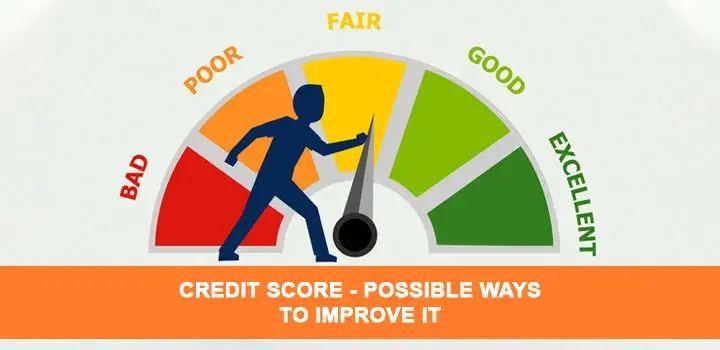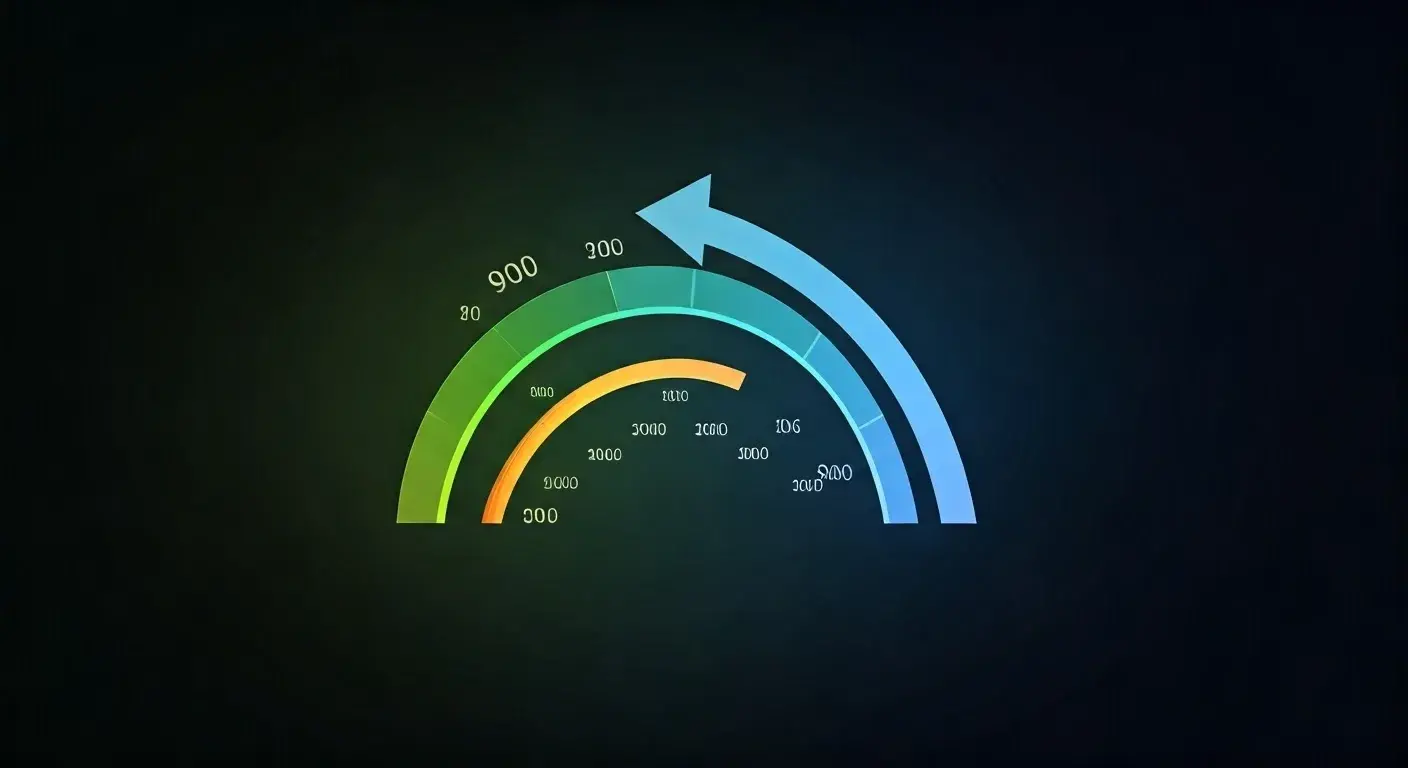-
Posted on: 24 Dec 2022

-
Unlocking a better financial future starts with a strong credit score. This guide reveals actionable, proven strategies to elevate your creditworthiness, from understanding the core components to implementing advanced tactics. Discover how to transform your financial standing and open doors to better loan terms, lower interest rates, and greater financial freedom.
Understanding Credit Scores: The Foundation of Your Financial Health
In the intricate world of personal finance, your credit score acts as a vital indicator of your financial responsibility. It's a three-digit number, typically ranging from 300 to 850, that lenders use to assess your creditworthiness. A higher score signifies a lower risk to lenders, translating into more favorable loan terms, lower interest rates, and easier approval for credit cards, mortgages, auto loans, and even rental applications. Conversely, a low score can present significant financial hurdles, leading to higher costs and limited access to credit. Understanding how these scores are calculated is the first crucial step toward improving them.
The most widely used credit scoring models are FICO and VantageScore. While their methodologies share many similarities, there can be slight variations in how they weigh different factors. However, the core components influencing your score remain consistent across both. These components are not created equal; some have a more profound impact on your score than others. Recognizing this hierarchy is key to prioritizing your efforts for maximum impact.
For 2025, the landscape of credit scoring continues to evolve, with a growing emphasis on accessibility and fairness. Lenders are increasingly looking for a holistic view of a consumer's financial behavior, moving beyond just traditional credit data. However, the fundamental principles of responsible credit management remain paramount. This guide will delve into each of these critical components and provide you with a roadmap to not only understand but actively improve your credit score.
How Credit Scores Are Calculated: The Key Factors
While the exact algorithms are proprietary, credit bureaus and scoring agencies have publicly disclosed the primary factors that contribute to your credit score. Understanding these factors allows you to strategically manage your finances to build a positive credit profile. The five main categories, with their approximate weightings, are:
- Payment History (35%): This is the single most influential factor. It reflects whether you pay your bills on time. Late payments, defaults, bankruptcies, and collections significantly damage your score.
- Amounts Owed (30%): This refers to how much credit you are using compared to your total available credit. This is often measured by your credit utilization ratio. High balances on credit cards can negatively impact your score.
- Length of Credit History (15%): This considers the age of your oldest account, the age of your newest account, and the average age of all your accounts. A longer history of responsible credit use generally leads to a higher score.
- Credit Mix (10%): This factor looks at the different types of credit you have, such as credit cards, installment loans (like mortgages or auto loans), and personal loans. Having a mix of credit types can be beneficial, but it's not as critical as payment history or amounts owed.
- New Credit (10%): This category considers how many new credit accounts you've opened recently and how many hard inquiries you have on your credit report. Opening too many accounts in a short period can signal higher risk.
By focusing your efforts on the categories with the highest weightings, you can achieve the most significant improvements in your credit score. For instance, consistently making on-time payments and keeping your credit utilization low will have a more substantial impact than simply opening a new type of credit account.
Payment History: The Cornerstone of Credit Improvement
As highlighted, payment history is the undisputed heavyweight champion of credit scoring, accounting for approximately 35% of your FICO score. This component is a direct reflection of your reliability in meeting your financial obligations. Lenders want to see a consistent track record of timely payments across all your credit accounts. The impact of a single late payment can linger for years, but consistent on-time payments build a strong foundation for a healthy credit score.
The Impact of Late Payments:
- 30-Day Late Payment: This is the least severe form of delinquency but can still cause a noticeable drop in your score, especially if your score is already high.
- 60-Day Late Payment: The negative impact increases significantly.
- 90-Day Late Payment: This is considered a severe delinquency and will have a substantial detrimental effect on your score.
- 120-Day Late Payment and Beyond: These are often reported as charge-offs or collections, which are among the most damaging events for a credit score.
Strategies for Ensuring On-Time Payments:
For 2025, the tools available to help consumers stay on track are more sophisticated than ever. Leveraging these can make a significant difference:
- Automate Payments: Set up automatic payments from your bank account for all your bills. Ensure you have sufficient funds in your account to cover these payments to avoid overdraft fees. This is the most foolproof method to prevent missed payments.
- Set Payment Reminders: Use calendar alerts, smartphone notifications, or even sticky notes to remind yourself of upcoming due dates.
- Pay More Than the Minimum: While paying the minimum on time is better than being late, paying more than the minimum can help reduce your overall debt faster, which indirectly benefits your credit utilization and overall financial health.
- Contact Lenders if You Anticipate a Problem: If you know you're going to have trouble making a payment, contact your lender *before* the due date. Many lenders are willing to work with you to find a solution, such as a temporary payment plan or deferment, which can prevent the delinquency from being reported to the credit bureaus.
Dealing with Past Due Accounts:
If you have missed payments in the past, the best course of action is to bring the account current as soon as possible. Even a past-due mark can significantly lower your score. Once an account is current, continue to make on-time payments to demonstrate renewed responsibility. While the late payment will remain on your report for up to seven years, its negative impact diminishes over time as you build a new history of positive behavior.
Example: Sarah missed a credit card payment by two days. Her score dropped by 20 points. She immediately paid the balance and set up autopay. Over the next year, she made all her payments on time, and her score began to recover, eventually surpassing its previous level as the late payment aged.
Credit Utilization Ratio: Mastering the Art of Borrowing Wisely
The credit utilization ratio (CUR) is the second most critical factor in determining your credit score, accounting for roughly 30% of your FICO score. It measures the amount of revolving credit you are using compared to your total available revolving credit. In simpler terms, it's the percentage of your credit limits that you are currently utilizing.
How to Calculate Your Credit Utilization Ratio:
The formula is straightforward:
(Total Balances on Revolving Credit / Total Credit Limits on Revolving Credit) * 100 = Credit Utilization Ratio (%)Example:
- You have two credit cards:
- Card A: Balance $1,000, Credit Limit $5,000
- Card B: Balance $500, Credit Limit $2,000
- Total Balances = $1,000 + $500 = $1,500
- Total Credit Limits = $5,000 + $2,000 = $7,000
- Credit Utilization Ratio = ($1,500 / $7,000) * 100 = 21.4%
Why a Low Credit Utilization Ratio Matters:
Lenders view a high credit utilization ratio as a sign of financial distress or over-reliance on credit. It suggests you might be struggling to manage your debts or are at a higher risk of defaulting. Conversely, a low utilization ratio indicates that you are managing your credit responsibly and are not overextended.
Ideal Credit Utilization Ratios for 2025:
While there's no single magic number, experts generally recommend keeping your overall credit utilization below 30%. However, the lower, the better. Many credit scoring models favor individuals with utilization ratios below 10%.
Strategies to Lower and Maintain a Low Credit Utilization Ratio:
- Pay Down Balances: The most direct way to lower your CUR is to pay down the balances on your credit cards. Focus on paying more than the minimum payment each month.
- Make Multiple Payments: If you have a high balance on a card, consider making multiple payments throughout the month rather than one large payment before the statement closing date. This can help keep the reported balance lower.
- Request Credit Limit Increases: If you have a good payment history with a particular credit card issuer, you can request a credit limit increase. If approved, this will increase your total available credit, thereby lowering your utilization ratio, assuming your balances remain the same. Be cautious, as some issuers may perform a hard inquiry for this.
- Do Not Close Unused Credit Cards: Closing a credit card reduces your total available credit, which can increase your utilization ratio even if your balances haven't changed. Keep older, unused cards open, especially if they have no annual fee.
- Spread Out Your Spending: If possible, distribute your spending across multiple credit cards rather than maxing out one or two.
Example: John had a credit card with a $2,000 balance and a $3,000 limit, resulting in a 66% utilization ratio on that card. He paid down the balance to $600. His utilization on that card dropped to 20%, significantly boosting his overall credit score.
Length of Credit History: Building a Legacy of Trust
The length of your credit history, accounting for about 15% of your FICO score, is a testament to your experience managing credit over time. Lenders prefer to see a longer history of responsible credit use because it provides more data points to assess your reliability. This factor considers three main elements:
- Age of Oldest Account: The longer your oldest credit account has been open and in good standing, the better.
- Age of Newest Account: A very new account will lower your average age of accounts.
- Average Age of All Accounts: This is the average age of all your active credit accounts.
Why Length Matters:
A longer credit history demonstrates that you have navigated different economic conditions and have consistently managed your credit responsibly. It provides lenders with a more robust picture of your financial behavior.
Strategies for Improving This Factor:
This is one of the more passive factors, as it largely depends on time. However, you can take steps to optimize it:
- Keep Old Accounts Open: As mentioned earlier, avoid closing your oldest credit accounts, especially if they have no annual fee. These accounts contribute positively to the age of your credit history.
- Avoid Opening Too Many New Accounts at Once: Each new account lowers the average age of your credit history. While new credit is necessary to build a credit profile, opening multiple accounts in a short period can negatively impact this factor.
- Become an Authorized User: If you have a trusted family member or friend with a long history of responsible credit use and a high credit limit on a credit card, they can add you as an authorized user. Their positive payment history and the age of the account can then be reflected on your credit report, potentially boosting your score. Ensure they maintain good habits, as their negative behavior can also affect you.
Example: Maria, at 25, had opened several credit cards in the last two years. Her average account age was only 1.5 years. Her father, with a 20-year-old credit card in excellent standing, added her as an authorized user. Her average account age immediately jumped to over 6 years, providing a significant boost to her score.
Credit Mix and New Credit: Diversifying and Strategizing
These two factors, each contributing about 10% to your FICO score, are less impactful than payment history or credit utilization but still play a role in your overall credit health. They represent how you manage different types of credit and your approach to seeking new credit.
Credit Mix: The Variety of Your Debt
Credit mix refers to the different types of credit accounts you have. Common types include:
- Revolving Credit: Credit cards, home equity lines of credit (HELOCs). These have variable balances and are typically paid back over time.
- Installment Loans: Mortgages, auto loans, student loans, personal loans. These have fixed monthly payments and a set repayment period.
Why It Matters:
Having a mix of credit types can show lenders that you can manage different forms of debt responsibly. However, it's crucial to understand that you don't need every type of credit to have a good score. For instance, someone with excellent payment history and low utilization on credit cards and a mortgage will likely have a good score even without other types of loans.
Strategies:
- Don't Open Accounts Just for Mix: The benefit of credit mix is often overstated. It's not advisable to open new accounts solely to diversify your credit mix if you don't need them, as this can incur hard inquiries and lower your average account age.
- Focus on Other Factors First: Prioritize managing your payment history and credit utilization. These will have a far greater impact than deliberately seeking out a diverse credit mix.
New Credit: The Impact of Recent Activity
This factor considers your recent credit activity, including how many new accounts you've opened and how many hard inquiries you have. Opening multiple new credit accounts in a short period can signal to lenders that you might be in financial distress or are a higher risk.
Hard Inquiries:
A hard inquiry occurs when a lender checks your credit report as part of a credit application (e.g., for a credit card, loan, or mortgage). Each hard inquiry can slightly lower your score, typically by a few points. Multiple hard inquiries within a short timeframe can have a more significant negative effect.
Soft Inquiries:
These occur when you check your own credit score, or when a company checks your credit for pre-approved offers. Soft inquiries do not affect your credit score.
Strategies:
- Space Out Applications: If you need to apply for new credit, try to space out your applications over several months or even a year.
- Shop for Rates Within a Short Window: For certain types of loans (like mortgages or auto loans), credit scoring models are designed to treat multiple inquiries for the same type of loan within a 14-45 day period (depending on the scoring model) as a single inquiry. This allows you to shop for the best rates without unduly harming your score.
- Avoid Unnecessary Applications: Only apply for credit when you genuinely need it.
Example: David applied for three different credit cards and a personal loan within a two-week period. This resulted in four hard inquiries and a noticeable drop in his credit score, making it harder for him to get approved for a car loan he needed soon after.
Actionable Strategies for Credit Score Improvement
Now that you understand the components of your credit score, let's dive into practical, actionable steps you can take to improve it. These strategies are designed to address the most impactful factors and provide tangible results.
1. Get Your Free Credit Reports and Review Them Thoroughly
The first and most critical step is to understand your current credit standing. You are entitled to a free credit report from each of the three major credit bureaus (Equifax, Experian, and TransUnion) every 12 months through AnnualCreditReport.com. For 2025, this service remains a vital tool for consumers.
Action:
- Visit AnnualCreditReport.com.
- Request your reports from all three bureaus.
- Carefully review each report for accuracy. Look for:
- Any accounts you don't recognize.
- Incorrect personal information (name, address, Social Security number).
- Errors in payment history (late payments marked incorrectly).
- Incorrect credit limits or balances.
- Duplicate negative entries.
Why it matters: Errors on your credit report can unfairly lower your score. Identifying and disputing these errors can lead to a quick and significant improvement.
2. Dispute Any Errors Found
If you find inaccuracies on your credit reports, you have the right to dispute them with the credit bureaus and the creditor that provided the information. The process for disputing errors is mandated by the Fair Credit Reporting Act (FCRA).
Action:
- Write a dispute letter to the credit bureau (and potentially the creditor) detailing the error and providing any supporting documentation (e.g., proof of payment, statements).
- Keep copies of all correspondence.
- The credit bureaus have approximately 30 days to investigate your dispute.
Example: Maria noticed a collection account on her report that she had already paid. She sent proof of payment to the credit bureau, and after investigation, the erroneous collection account was removed, boosting her score by 15 points.
3. Aggressively Pay Down Credit Card Balances
As discussed, credit utilization is a major score driver. Reducing your balances is paramount.
Action:
- Prioritize paying down cards with the highest utilization ratios first (this is known as the "debt avalanche" method, which saves you the most money on interest).
- Alternatively, focus on paying down the smallest balances first (the "debt snowball" method), which can provide psychological wins and motivation.
- Aim to keep your overall credit utilization below 30%, and ideally below 10%.
- Consider making payments more frequently than monthly to keep reported balances low.
Why it matters: Lowering your utilization ratio directly signals to lenders that you are managing your credit responsibly and are not overextended.
4. Make All Payments On Time, Every Time
Payment history is the most critical factor. Never miss a payment.
Action:
- Set up automatic payments for all your bills.
- Use calendar reminders or budgeting apps.
- If you anticipate a difficulty, contact your lender *before* the due date to arrange a solution.
Why it matters: Consistent on-time payments build a positive credit history, which is the strongest foundation for a high credit score.
5. Avoid Closing Old, Unused Credit Accounts
Closing older accounts can reduce your average age of credit and decrease your total available credit, potentially increasing your utilization ratio.
Action:
- Keep your oldest credit cards open, even if you rarely use them, provided they don't have an annual fee.
- Use them occasionally for small purchases and pay them off immediately to keep them active.
Why it matters: Older accounts contribute positively to the length of your credit history and your overall available credit.
6. Consider a Secured Credit Card
If you have a poor credit history or no credit history at all, a secured credit card can be an excellent tool for rebuilding or establishing credit.
Action:
- Apply for a secured credit card. You'll typically need to provide a cash deposit, which then becomes your credit limit.
- Use the card responsibly: make small purchases and pay the balance in full and on time each month.
- After a period of responsible use (usually 6-12 months), the issuer may convert your secured card to an unsecured card and refund your deposit.
Why it matters: Secured cards report to credit bureaus, allowing you to build a positive payment history and improve your credit utilization.
7. Become an Authorized User (Strategically)
If you have a trusted friend or family member with excellent credit, they can add you as an authorized user to one of their credit cards.
Action:
- Ensure the primary cardholder has a long history of on-time payments and low credit utilization on that card.
- Understand that their positive (or negative) behavior on that account will affect your credit report.
Why it matters: This can help boost your credit history length and potentially your credit utilization, depending on how the issuer reports authorized users.
Dealing with Negative Marks on Your Credit Report
Negative marks can significantly impact your credit score, but understanding how to address them is crucial for improvement. These marks include late payments, collections, charge-offs, bankruptcies, and foreclosures.
Late Payments
Impact: The severity depends on how late the payment was (30, 60, 90+ days). A single 30-day late payment can drop a good score by 50-100 points. Multiple late payments have a compounding negative effect.
Strategy:
- Bring the account current immediately.
- Continue making on-time payments to demonstrate responsible behavior moving forward.
- Wait for it to age off your report (typically 7 years from the original delinquency date).
Collections and Charge-Offs
Impact: These are severe negative marks. A charge-off occurs when a lender deems a debt uncollectible and writes it off. A collection account is when the debt is sent to a third-party agency to collect. Both significantly lower your score.
Strategy:
- Contact the collection agency: You can attempt to negotiate a "pay-for-delete" agreement, where you pay a portion or all of the debt in exchange for them removing the item from your credit report. While not guaranteed, it's worth trying.
- Pay the debt: Even if "pay-for-delete" isn't successful, paying the debt is generally advisable, as a paid collection looks better than an unpaid one. However, be aware that paying the debt can sometimes reset the clock on how long it stays on your report, depending on the state and the specific debt.
- Dispute inaccuracies: If the collection or charge-off is not yours or is reported inaccurately, dispute it with the credit bureaus.
Bankruptcies and Foreclosures
Impact: These are the most damaging events and can stay on your report for 7-10 years. They indicate a severe inability to manage debt.
Strategy:
- Focus on rebuilding: After these events, the primary strategy is to focus on building a new, positive credit history from scratch.
- Use secured credit cards and credit-builder loans.
- Be patient: The impact will lessen over time as these marks age, and your consistent positive behavior builds a new track record.
Settling Debt Responsibly
When dealing with delinquent accounts or collections, consider settling the debt. This means paying less than the full amount owed.
Action:
- Negotiate: Contact the creditor or collection agency and offer a lump sum settlement for less than the full amount.
- Get it in writing: Always obtain a written agreement detailing the settlement terms *before* making any payment. Ensure the agreement states that the debt is settled in full.
- Understand the impact: A settled debt will still appear on your credit report, but it's generally better than an unpaid collection. The credit report may show "settled for less than full amount."
Consider Credit Counseling
If you are overwhelmed by debt and struggling to manage your finances, a reputable non-profit credit counseling agency can provide guidance.
Action:
- Seek out agencies accredited by organizations like the National Foundation for Credit Counseling (NFCC) or the Financial Counseling Association of America (FCAA).
- They can help you create a budget, negotiate with creditors, and potentially set up a Debt Management Plan (DMP).
Why it matters: A DMP involves making one monthly payment to the agency, which then distributes it to your creditors. This can help you catch up on payments and avoid further damage to your credit score.
Advanced Techniques and Considerations for Credit Elevation
Beyond the fundamental strategies, several advanced techniques and considerations can further optimize your credit score. These are particularly useful for those aiming for top-tier scores or facing specific credit challenges.
Understanding Different Credit Scoring Models
As mentioned, FICO and VantageScore are the most common. However, there are many industry-specific FICO scores (e.g., FICO Auto Score, FICO Bankcard Score) and different versions of these models. For 2025, lenders may use the latest versions, which might weigh factors slightly differently.
Action:
- Be aware that your score might vary slightly depending on which model is used.
- Focus on the core principles of good credit management, as these apply across most models.
Credit for Rent and Utilities
In recent years, services have emerged that allow consumers to report rent and utility payments to credit bureaus. These can be beneficial for individuals who have a limited credit history or struggle with traditional credit products.
Action:
- Research services like Experian Boost, RentReporters, or LevelCredit.
- Understand the fees associated with these services and how they report to the bureaus.
- Ensure your landlord or utility provider is willing to participate if required.
Why it matters: Consistent, on-time payments for rent and utilities can help build a positive credit history, especially if you have few other credit accounts.
Credit-Builder Loans
These are small loans designed specifically to help individuals build or improve their credit history. You make payments on the loan, but the loan amount is held in a savings account by the lender and is released to you only after the loan is fully repaid.
Action:
- Shop around for credit-builder loans at local credit unions or community banks.
- Make all payments on time.
Why it matters: This demonstrates a consistent ability to repay a loan, which is reported to credit bureaus and can improve your score.
Negotiating with Creditors
If you're struggling with existing debt, don't hesitate to negotiate with your creditors.
Action:
- Payment Plans: Ask for a more manageable payment plan.
- Interest Rate Reduction: Request a temporary or permanent reduction in your interest rate.
- Waiving Fees: Inquire about having late fees or other charges waived.
Why it matters: Proactive communication can prevent accounts from becoming delinquent or going into collections, thus protecting your credit score.
Regular Credit Monitoring
Staying on top of your credit health is an ongoing process.
Action:
- Use free credit monitoring services: Many credit card issuers and financial institutions offer free credit score monitoring.
- Set up alerts: Many services allow you to set up alerts for significant changes to your credit report or score.
- Review your reports periodically: Even if you have monitoring, a full review of your credit reports every 6-12 months is recommended.
Why it matters: Early detection of issues or negative trends allows you to address them promptly before they cause significant damage.
Maintaining a Healthy Credit Score for Long-Term Success
Improving your credit score is a significant achievement, but maintaining it requires ongoing diligence. The principles of good credit management are consistent, but vigilance is key to long-term financial health.
Consistency is Key
The most effective way to maintain a high credit score is to consistently practice good financial habits. This means making all payments on time, keeping credit utilization low, and avoiding unnecessary credit applications.
Avoid Sudden Changes in Financial Behavior
Sudden shifts, such as taking on a large amount of new debt or missing several payments, can negatively impact your score. Gradual, responsible changes are always better.
Stay Informed About Your Credit
Periodically check your credit reports and scores. This allows you to catch any potential issues early and understand how your financial decisions are affecting your creditworthiness.
Plan for Major Purchases
If you anticipate needing to borrow a significant amount for a home or car, ensure your credit score is in excellent shape well in advance. This will secure the best possible interest rates, saving you thousands of dollars over the life of the loan.
The Long Game
Building and maintaining excellent credit is a marathon, not a sprint. It requires patience, discipline, and a commitment to responsible financial behavior. The rewards, however, are substantial and long-lasting, opening doors to financial opportunities and stability.
By diligently applying the strategies outlined in this comprehensive guide, you can effectively improve your credit score and build a strong financial foundation for the future. Remember that every positive action you take contributes to a better credit profile, leading to greater financial freedom and peace of mind.
In conclusion, achieving and maintaining an excellent credit score is within your reach. By prioritizing on-time payments, managing credit utilization diligently, and reviewing your credit reports regularly, you lay the groundwork for financial success. Embrace these strategies as a continuous part of your financial journey, and you'll unlock better loan terms, lower interest rates, and a world of financial opportunities. Start today, and watch your financial future transform.











